10 fence line landscaping ideas – beautify your boundaries, with expert insights from landscape designers
There are many stylish ways to incorporate your fence into the rest of your design scheme
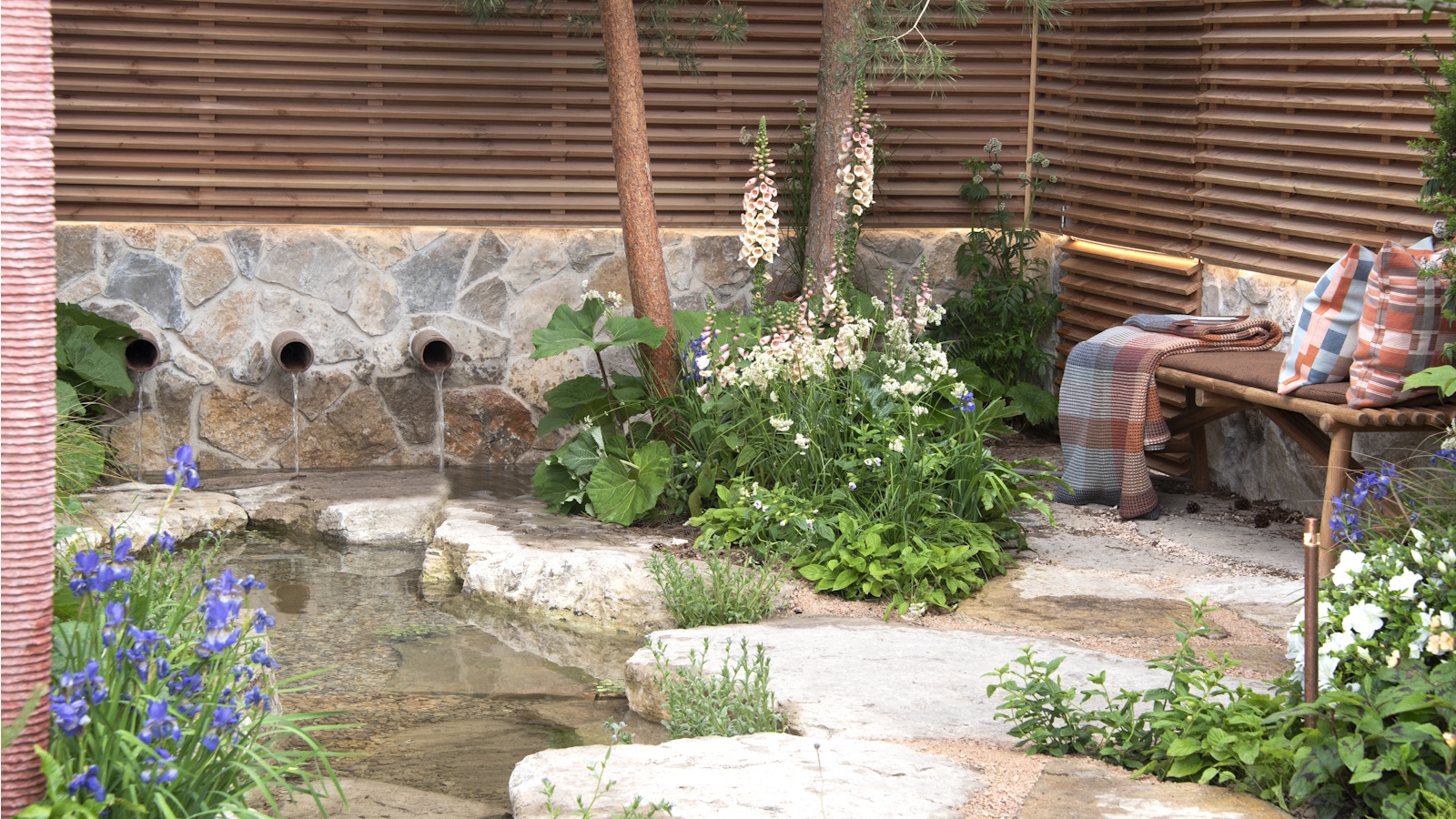
- 1. Build a raised bed alongside your fence
- 2. Support a flowering climber
- 3. Keep an open view between garden zones
- 4. Plant a line of standard trees for an orderly look
- 5. Create layers of greenery with pots
- 6. Mix up the textures
- 7. Incorporate wildlife-friendly features
- 8. Opt for a drought-tolerant design
- 9. Combine intricate fences with bold blooms
- 10. Add a water feature for a focal point
- FAQs

For many of us, a garden fence is a necessity for defining boundaries, as well as enhancing the feeling of privacy and security in our homes. There are plenty of types to choose from – be it a classic wooden, weathering steel, or colorfully-painted design. However, the adjacent landscaping should also be considered to create a fully cohesive look.
Careful plant selection and other design elements can be utilized to complement your garden fence, and integrate it with your overall theme. The possibilities are (almost) endless, whether you want to soften your fence’s overall appearance, turn it into a focal point, or even make the space a wildlife-friendly haven.
Below, you’ll find 10 beautiful fence line landscaping ideas, from minimal, contemporary looks to flower-filled styles. Plus, landscape designers share plant recommendations for these spots.
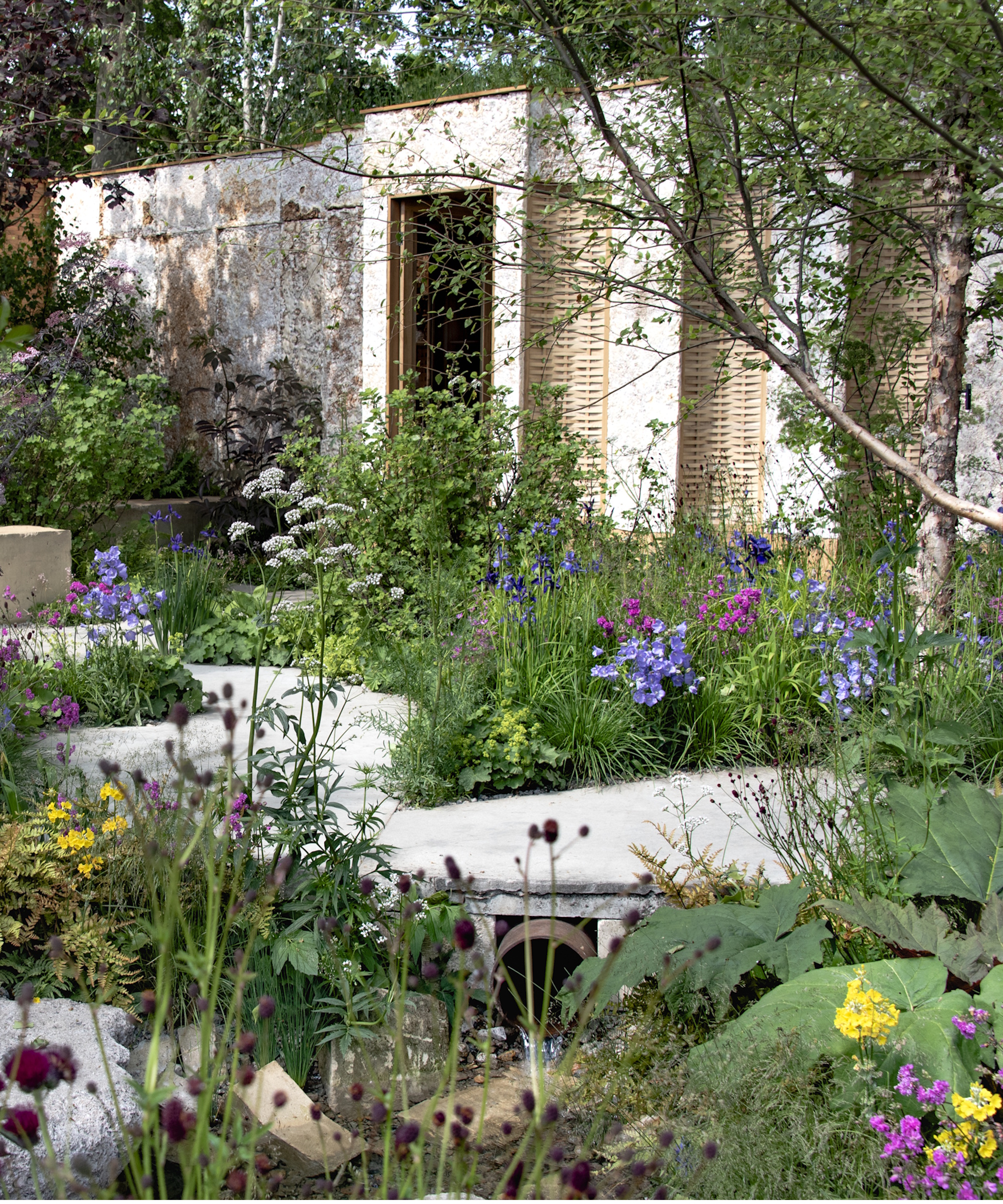
10 fence line landscaping ideas that prove boundaries needn't be boring
Whether you prefer a modern design or a cottage-garden-style scheme, something in this mix is sure to inspire.
1. Build a raised bed alongside your fence
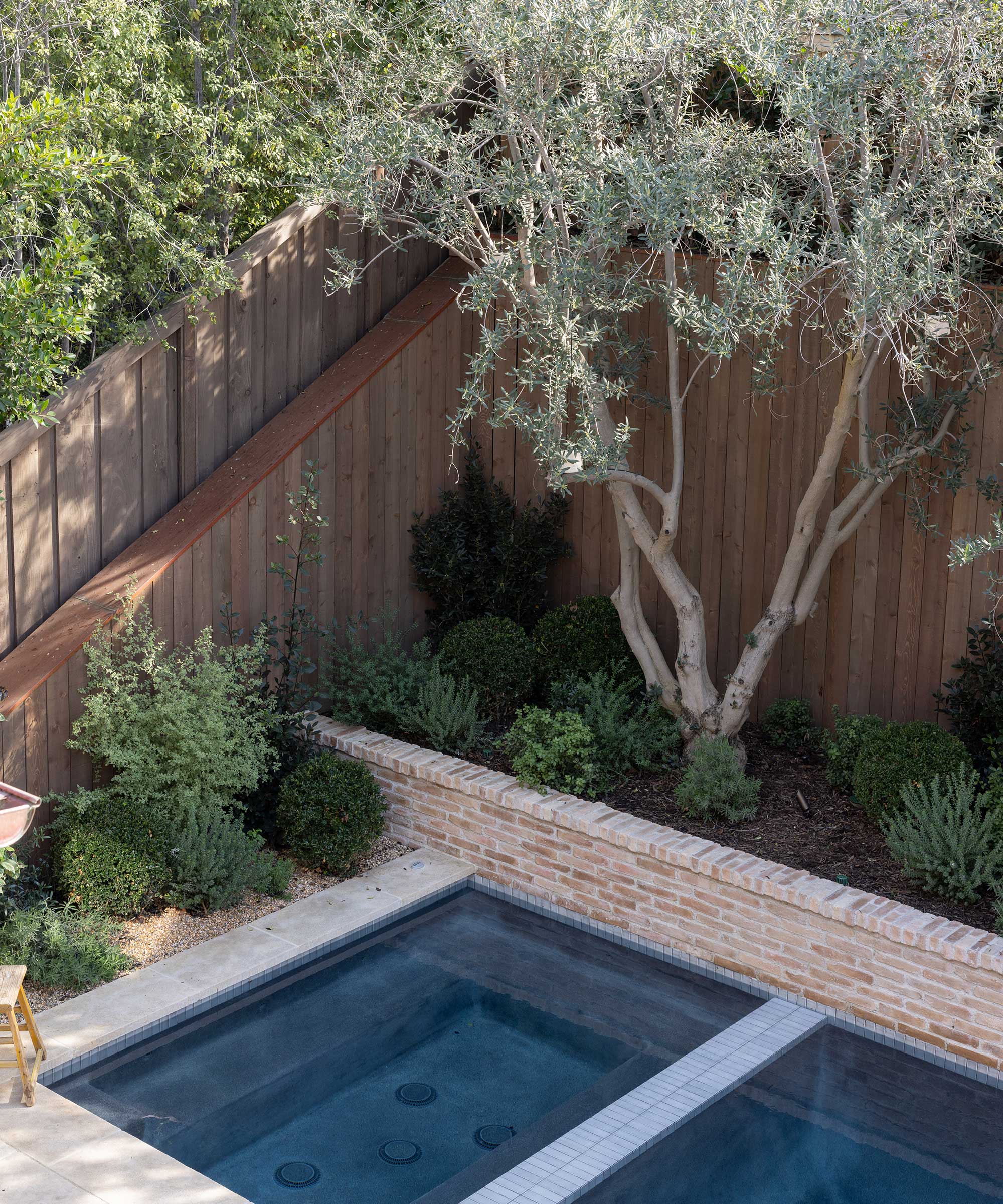
Chris Fenmore, founder and principal designer for Garden Studio Design, explains that this fence line is not just a fence, but also a retaining wall.
‘We faced the concrete retaining wall with stain-grade vertical cedar planking and matched the stain of the back fence line to that of the house, so that the entire project has uniformity,’ she says. Note the copper cap used here, too, which adds another interesting detail.
The brick raised bed brings extra color, texture, and form to the space. ‘We lined the entire back fence line with a row of established canopy trees; these are field-grown olive trees,’ says Chris.
Design expertise in your inbox – from inspiring decorating ideas and beautiful celebrity homes to practical gardening advice and shopping round-ups.
‘Not only did this give instant garden privacy, but it also provided an anchor and a backdrop to the entire backyard. Large and more established trees give a sense of scale as well as a sense of destination.’ Hanging lights and uplights are also included, she notes.
‘The plants at the base of the trees are low,’ Chris continues. ‘Once established, they will grow to be about 30-36 inches tall, leaving the stain-grade wood open and to be enjoyed at eye level. This is as opposed to planting a hedge, which takes up more depth and makes a yard feel smaller.
'Allowing the back fence to remain visible through the trees and shrubs gives more of a sense of open space as opposed to feeling closed off by a hedge,' she explains.
Plants chosen include Buxus japonicum ‘Globe’, Pittosporum tenuifolium ‘Golf Ball’, and Prostanthera ovalifolia ‘Verigata’, among others. ‘We like them for the combination of various green on green foliage – some are bright green and some are gray-green,’ says Chris. ‘They also have various round and mounding shapes. These contrasts are interesting to the eye.’

Chris has been shaping landscapes for over 30 years. Through her firm, Garden Studio Design, she leads residential and commercial projects across California and beyond. From initial sketches to permit submittals and breaking ground, Chris takes a hands-on approach every step of the way. It’s a detail-driven process – but for her, it’s a calling. She’s deeply passionate about creating spaces that foster peace, purpose, and a true connection to the outdoors.
2. Support a flowering climber

Elena Fox, a landscape designer at Terremoto, says, ‘In this space, the fence serves a dual purpose – not just as a boundary, but as scaffolding for vines and taller plants to climb.
'By encouraging plants to grow vertically, the design invites the fence to visually recede, softening its presence and blending it into the landscape. The lush planting creates a sense of intimacy and enclosure without feeling closed off. This approach transforms a utilitarian element into a vibrant, living wall that enhances the garden’s overall sense of calm and seclusion.’
Scented jasmine, like this star jasmine from Nature Hills, is a lovely choice for upping the sensory appeal, as its blossoms will fill the air with a sweet perfume. There are lots of other easy climbing plants to choose from, too, including clematis, and a wide range of plants for a flowering living wall.
If you can't plant straight into the ground, a planter box and trellis situated next to the fence can also be used to create a similar effect.

Elena Fox is a landscape designer with a background in architecture and art fabrication, bringing a deep appreciation for placemaking and materiality to her work. Her practice emphasizes site-specific work that reflects the narratives and contexts of the materials, ecologies, and people that belong to a place. At Terremoto, Elena practices design stewardship on a range of projects, both residential and commercial. She is passionate about vernacular building methods and incorporates locally sourced, sustainable materials whenever possible.
3. Keep an open view between garden zones
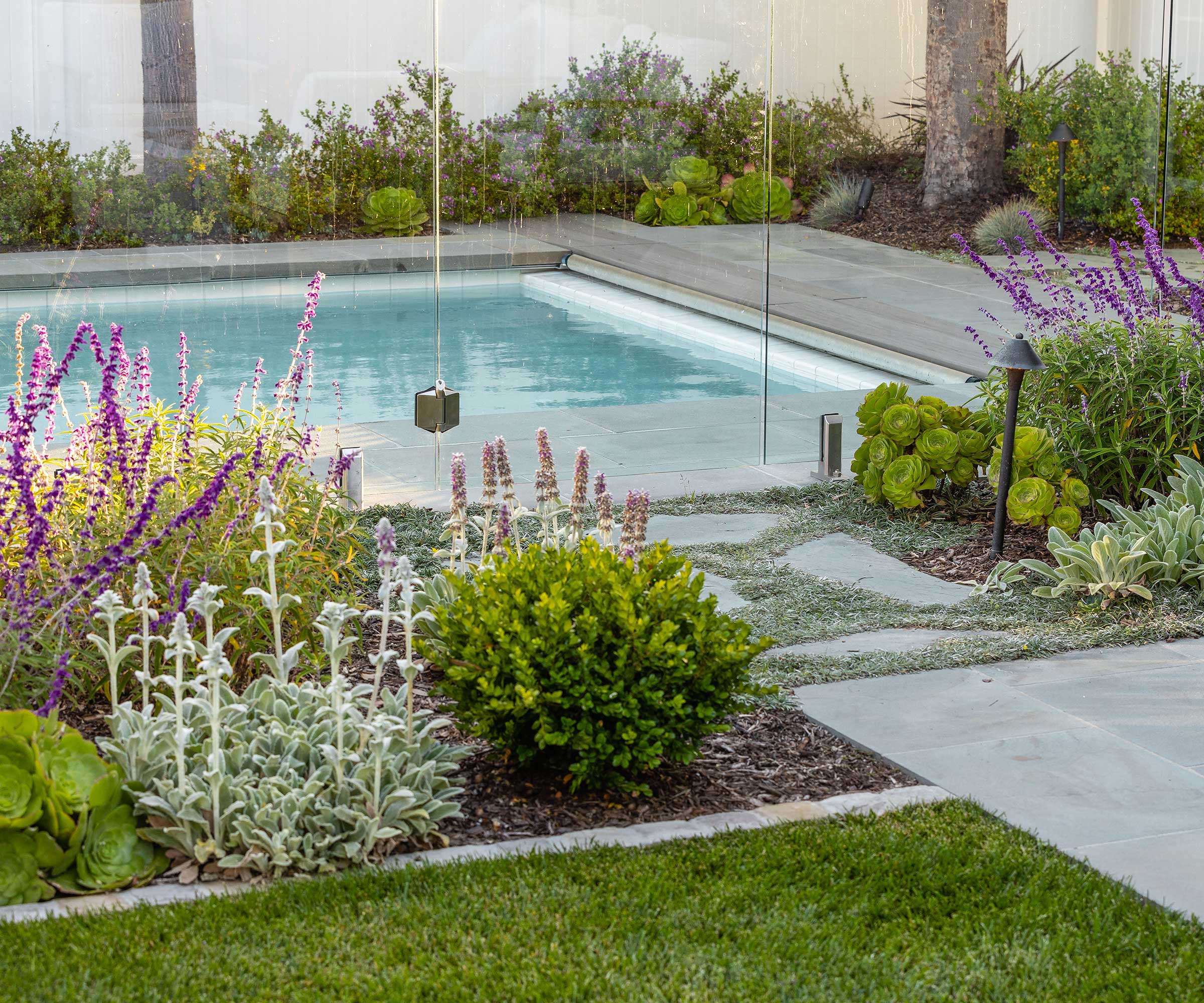
Fences aren’t just for the perimeter of plots – they can also be used for garden zoning. In this project, Sacha McCrae, founder of Living Gardens Landscape Design, explains that the family envisioned their backyard as a destination for connection – spaces for lounging, dining, and gathering around a fire pit – while ensuring the existing swimming pool remained visually and spatially integrated with the garden.
‘We introduced all-new hardscape and updated the pool finishes, seamlessly blending the pool area with the surrounding landscape,’ she says. ‘A frameless, pool-safe glass screen now encloses the water, preserving uninterrupted views of the pool and spa while meeting safety requirements.
‘Designed with future grandchildren and young visitors in mind, the glass barrier keeps the pool secure: the latch is placed well out of reach for little ones, ensuring they can only enter with adult supervision.
'Unlike traditional fencing, the transparent railing maintains a sense of openness, preventing the pool zone from visually fragmenting the garden,' Sacha explains.
The low-height planting enhances this feeling of openness while adding soft textures and pops of purple, which are mirrored in the pool area beyond. Large, striking succulents are also used on both sides of the pool fence line, further contributing to the cohesiveness of the design.
You can find frameless, glass fence panels like this at Amazon.

Sacha McCrae is the founder and designer at Living Gardens Landscape Design, a boutique Orange County, California, garden design company. Living Gardens creates welcoming outdoor rooms that are beautiful and functional, incorporating natural materials and lush, drought-tolerant plant palettes.
4. Plant a line of standard trees for an orderly look

‘In this example, the fence is a raw vertical plank cedar fence,’ says Chris Fenmore. ‘This fence will naturally fade to a light gray color. A fence like this is less maintenance than the stain fence and will age nicely over time.’
A row of standard trees is planted in front. ‘Standard trees can be thought of as lollypop-shaped,’ explains Chris. Like in the other Garden Studio Design project shown above, Chris says they wanted screening from the back neighbors, but did not want the closed-off feeling of a full hedge, so opted to let the canopy of the trees start above the fence line allowing a few layers of plantings below.
With a row of landscape lighting, the cedar plank wood glows and is part of the open look, Chris adds.
‘With this example, we wanted clean and tidy rows of plants,’ she continues. 'A double layer of boxwood hedges are clean, simple, and easy to maintain. The layers of structured green on green with the pop of cedar planking all work together to create a tailored look that is pleasing to the eye.'
Looking to recreate something similar? Chris shares their favorite standard tree varieties: Prunus caroliniana ‘Compacta’, Ficus nitida, and Laurus nobilis (available at Fast Growing Trees).
5. Create layers of greenery with pots
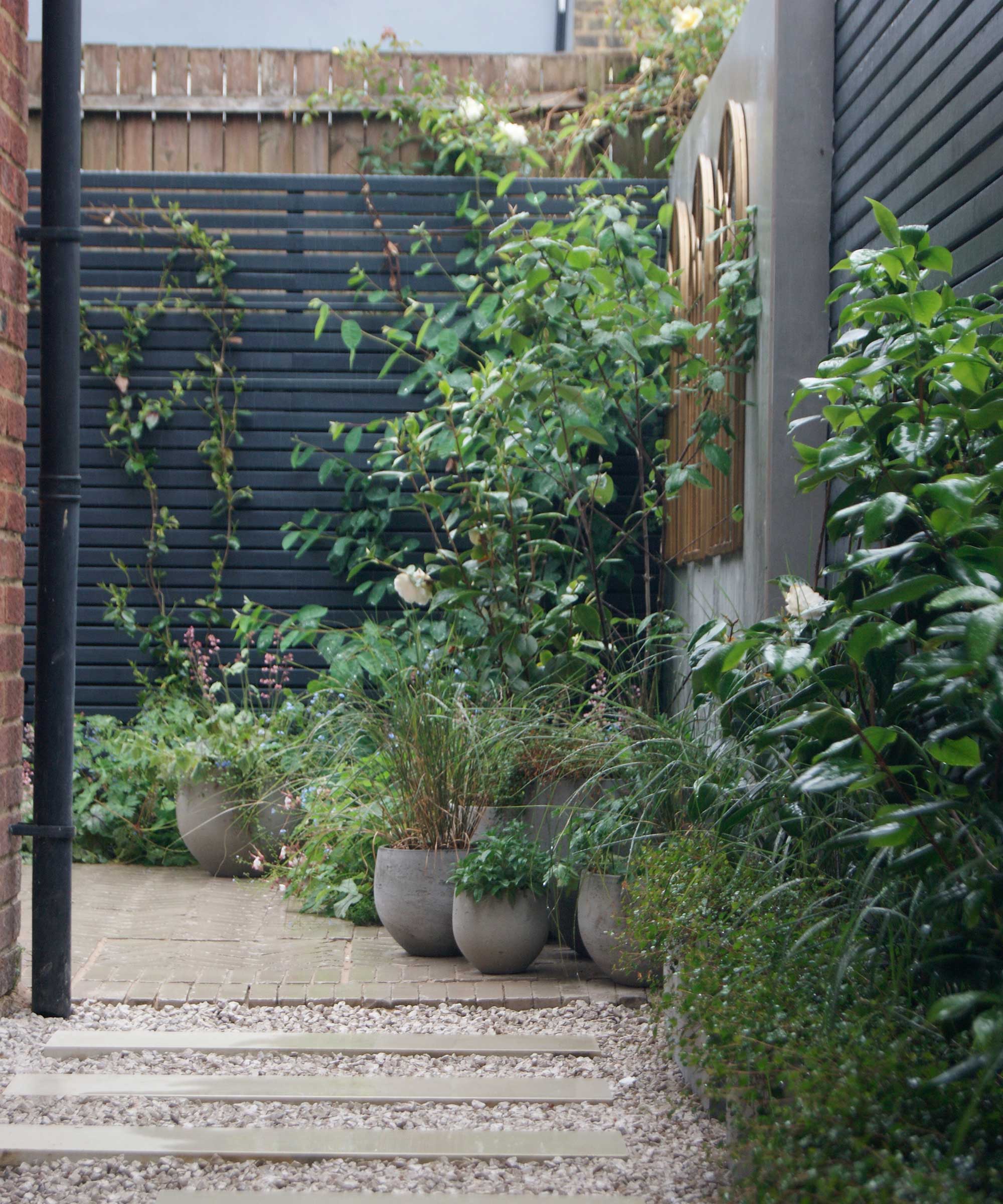
This fence has been painted with Thorndown Paints' wood paint in 'Anthracite'
Digging borders or constructing raised beds isn’t always possible, particularly in courtyards and small gardens. If this is the case with your backyard, consider bringing life to your fence line by planting a container garden instead.
Choosing pots in a similar or complementary color scheme helps to create an intentional and curated aesthetic. Go for different sizes and heights for a sense of layering, positioning the larger planters at the back to ensure you can see everything clearly.
A wide range of stylish outdoor planters is available from Wayfair. Just remember to water all containers when needed to keep everything thriving.
In this example, the dark fence color behind really helps the lush greenery of the plants stand out and adds to the contemporary tone. Outdoor mirrors, too, make a good addition – not only do they fill an empty space, but they also help to bounce light around and can make a compact yard feel larger.
6. Mix up the textures
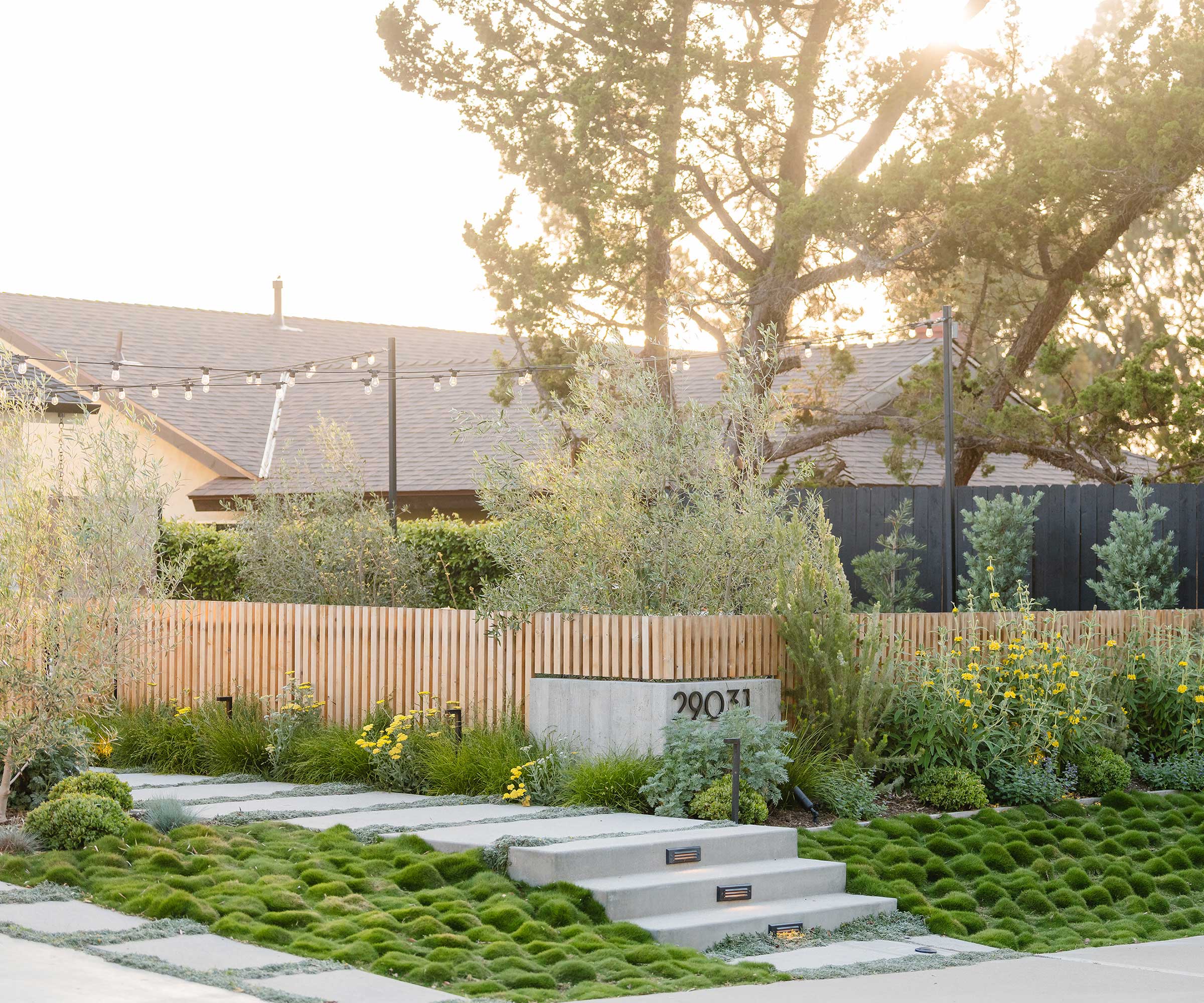
This front yard landscaping layers interesting textures and playful design features, including the use of ground cover plants.
‘Before the renovation, the front yard was a wide expanse of plain lawn – open but underutilized,’ says Sacha McCrae. ‘Our goal was to transform it into a welcoming extension of the home: a space for gathering, dining, and unwinding around the fire.
‘We introduced a low perimeter fence that subtly defines the space without compromising the sweeping views of the nearby hills. The result is a front yard that feels both open and private – an intimate outdoor room that adds meaningful living space to the home’s footprint.
'A restrained palette of natural wood and concrete grounds the design and reflects the modern, youthful spirit of the family,' Sacha continues. 'Grasses and flowering shrubs soften the hardscape and animate the garden with seasonal color and movement, creating a relaxed, contemporary landscape that feels both intentional and effortless.’
7. Incorporate wildlife-friendly features
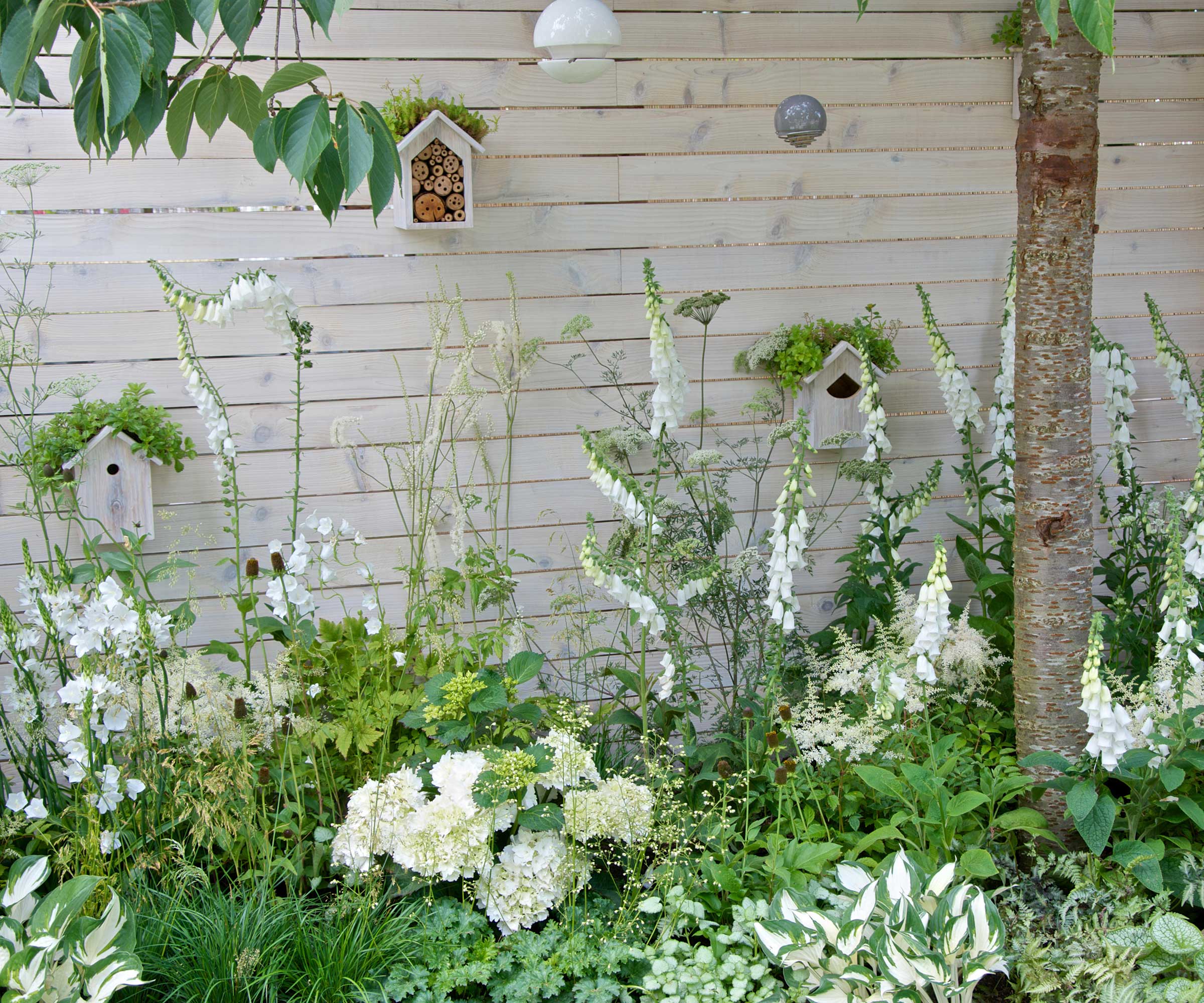
The 'Living Landscapes: City Twitchers Garden', designed by Sarah Keyser
Traditionally, hedges have more benefits to wildlife than fences. Some have berries for birds, others have spring flowers that entice pollinators, and all can offer some sort of leafy shelter.
However, if you’d rather the look and upkeep of a fence, there are ways to transform it into a haven for visiting creatures.
Fixing bug hotels (like this beautiful teal bug hotel from Amazon) or small bird boxes (like this one from Amazon) to the fence is a good place to start, or perhaps you could nestle a bird bath alongside (but be sure to clean your bird bath often).
When it comes to planting along your fence line, opt for pollinator-friendly plants (double-bloomed varieties, such as some types of dahlias, are best avoided as the pollen is harder to access).
Be sure to include winter plants for wildlife, too, to help them through the coldest months. You may also wish to plant a small tree to provide somewhere for birds to take cover – and you could also hang a bird feeder from its branches.
8. Opt for a drought-tolerant design

Sometimes, a subtle approach is called for when marking out a boundary.
Elena Fox says, ‘The fence in this landscape is thoughtfully designed to feel more like an outline than a barrier, gently delineating space without creating division. By staggering the wooden slats and interweaving them with layered plantings of varying heights, the design effectively begins to erase the fence, softening its presence.
‘Lush, drought-tolerant vegetation spills through and around the structure, encouraging visual and ecological continuity,’ she continues. ‘The result is a landscape that feels open, welcoming, and deeply neighborly – one that prioritizes connection over separation.’
Choosing drought-tolerant plants, such as succulents, is also an effective way to keep maintenance down – as is opting for gravel around them. Our guides on designing a drought-tolerant yard and xeriscaping have lots more advice on this type of style.
9. Combine intricate fences with bold blooms
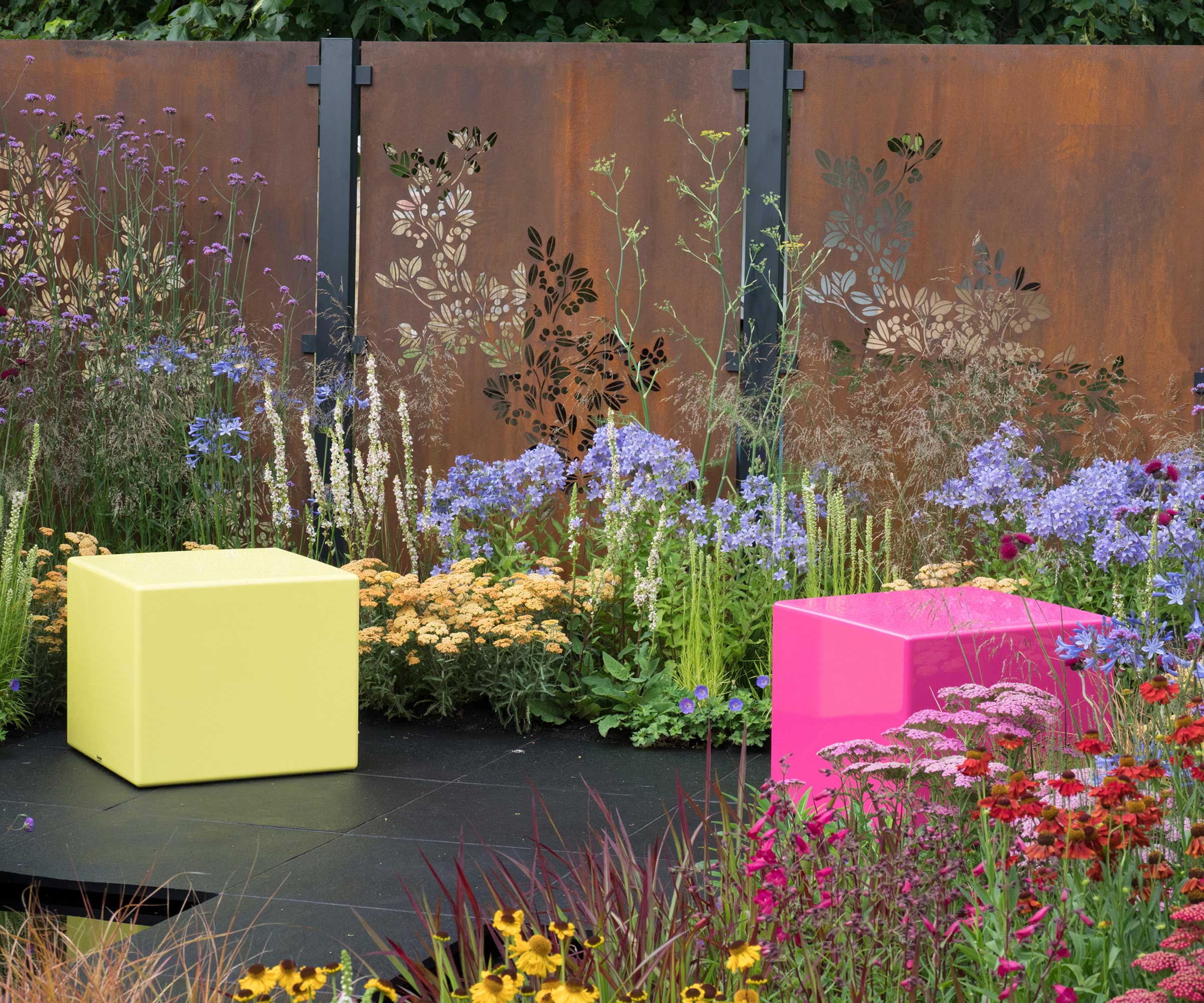
Weathering steel is a durable choice for fencing (or garden edging), and brings a sense of industrial cool to any backyard.
Its natural, rusted patina adds warmth to a color palette and often makes it a stand-out feature in itself, rather than just a functional boundary line. This is particularly the case if it includes an intricate, cut-out design, as shown in the example above.
Weathering steel can work beautifully alongside a minimal yet sculptural planting scheme – think tightly-clipped shrubs or ornamental grasses in pared-back tones, for instance.
However, it can also serve as a bold backdrop for an explosion of color, as seen here, where bright, painterly borders complement the botanically-themed panels. The overall look is full of abundance and fun, with perennials such as helenium, yarrow, penstemons, and Verbena bonariensis offering long-lasting summer joy.
Meanwhile, black stone tiling underfoot provides a contemporary contrast against the tapestry of tones.
10. Add a water feature for a focal point
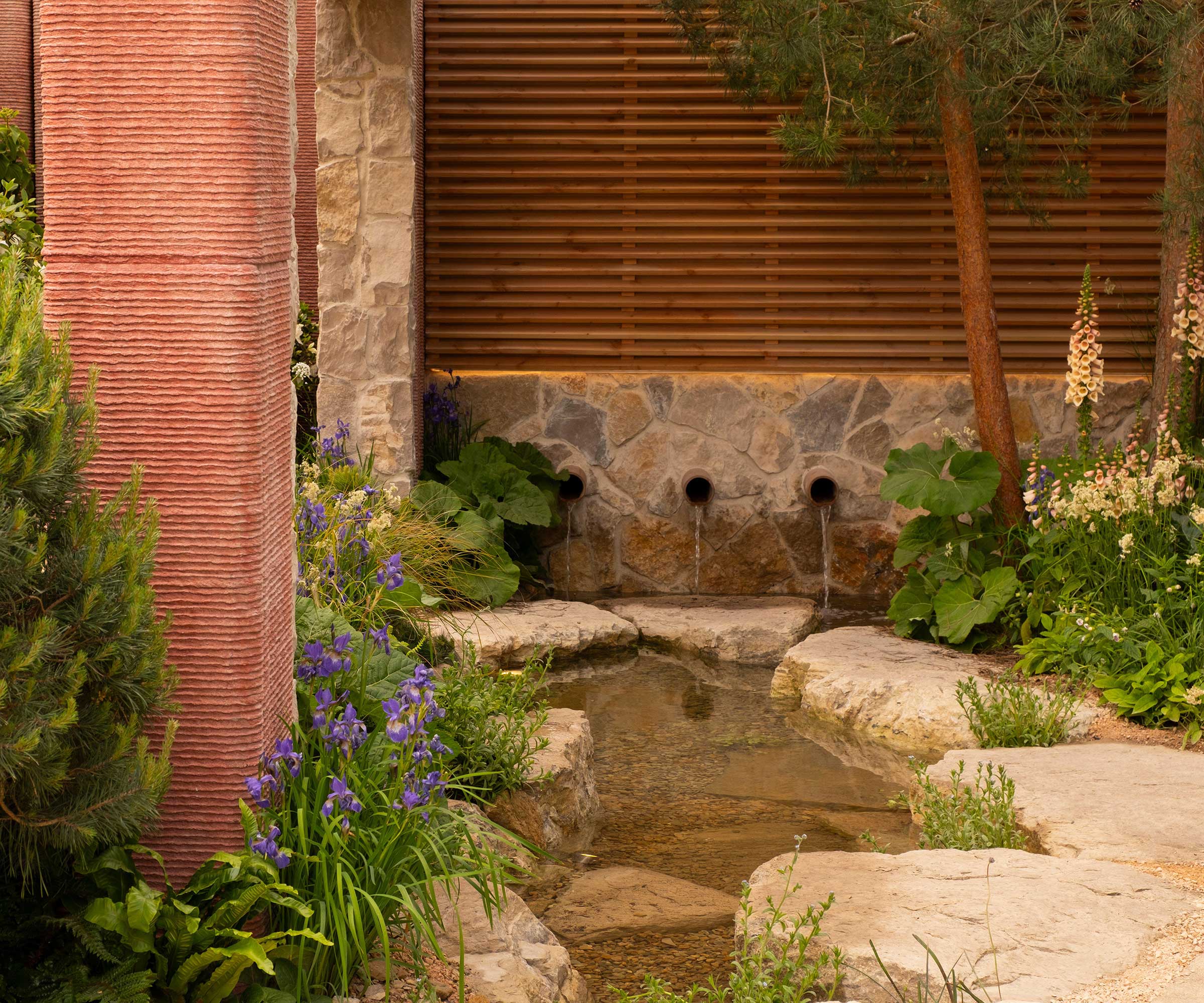
The famous RHS Chelsea Flower Show in England, UK always provides plenty of inspiration for our backyards. And in this gold-medal-winning design by Baz Grainger, the fence line is anything but boring.
The boundary is utilized as a focal point, combining rustic stone and neat slatted wood with a minimalistic water feature – which then channels through the garden. Pockets of relaxed planting, with green, peach, and purple hues, tie the space together and add to the natural vibe.
If you’re not looking for a large landscaping update but like the idea of bringing water into your space, there are plenty of water garden ideas you can adopt. Perhaps consider placing a small fountain (from Walmart) or water bowl beside your fence, cocooned in ornamental grasses, flowering shrubs, or herbaceous perennials.
FAQs
What are some recommended plants for along a fence line?
When picking plants, it’s always best to consider what will work well with the conditions you have, which means taking into account factors such as your US hardiness zone. Of course, you’ll also want to think about their eventual sizes, and how they will fill the space.
Elena Fox, a landscape designer at Terremoto, shares that the plants she works with are always site-specific, both in terms of regionality and function. ‘Since we mainly work in California, my favorite native evergreen shrubs for a fence we might wish to conceal are silk tassel bush (Garrya elliptica) and Pacific wax myrtle (Myrica californica).
'For fences where we might want to layer verdancy in front and behind, I love using wispy, sculptural plants such as desert mallow (Sphaeralcea ambigua), Santa Cruz Island buckwheat (Eriogonum arborescens), and red flowering currant (Ribes sanguineum),' she adds.
Sacha McCrae, founder of Living Gardens Landscape Design, says, ‘Grasses are a favorite tool of mine for softening the lines of a fence – introducing texture, movement, and a sense of ease to the garden. Paired with a sculptural succulent, the contrast feels both deliberate and modern.
‘A touch of color can elevate the composition, but I prefer to keep it focused: a single bloom tone reads cleaner, more contemporary,’ Sacha continues. ‘Simplicity is key – limit the plant palette and repeat selections for a cohesive, high-impact result.’
What color should you paint your fence?
Painting a wooden fence can have transformative effects, but the color is all down to personal preference and the look you want to achieve. For instance, black or dark gray is always a modern choice, while stained wood allows the natural patina to shine through. Some fence colors can even make your space look larger, and there are some fence colors that add to the value of your home.
As the ideas above demonstrate, fence line landscaping doesn’t have to be dull. But of course, for long-lasting impact, it’s important to keep the fence itself looking its best – no matter what design choices you make. To do so, our guide on how to remove algae from a fence may come in handy.

Holly started writing about gardening five years ago, and she is a regular contributor to Homes & Gardens. She has also written many gardening features for Woman & Home and Real Homes, too. She has previous experience as a professional gardener, where she helped to plant and maintain private gardens. Holly has also looked after allotment plots over the years and loves to grow her own flowers and veggies from seed. In her spare time, she enjoys visiting local gardens, botanical drawing, and tending to her ever-growing collection of houseplants.
You must confirm your public display name before commenting
Please logout and then login again, you will then be prompted to enter your display name.